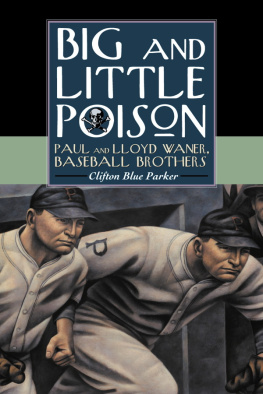
Table of Contents
Also by Clifton Blue Parker
Fouled Away: The Baseball Tragedy of Hack Wilson (McFarland, 2000)
Library of Congress Cataloguing-in-Publication Data
Parker, Clifton Blue, 1963
Big and little poison : Paul and Lloyd Waner, baseball brothers /
Clifton Blue Parker.
p. cm.
Includes bibliographical references and index.
ISBN-13: 978-0-7864-1400-0
1. Baseball playersUnited StatesBiography. I. Title: Paul and
Lloyd Waner, baseball brothers. II. Waner, Paul. III. Waner, Loyd.
IV. Title.
GV865.A1 P37 2003
796.357'092'2dc21 2002014638
British Library cataloguing data are available
2003 Clifton Blue Parker. All rights reserved
No part of this book may be reproduced or transmitted in any form or by any means, electronic or mechanical, including photocopying or recording, or by any information storage and retrieval system, without permission in writing from the publisher.
Cover illustration by Mike Benny. Design by Seraphein Beyn, Inc.
McFarland & Company, Inc., Publishers
Box 611, Jefferson, North Carolina 28640
www.mcfarlandpub.com
To Rhiannon,
daughter of the diamond
Acknowledgments
Id like to thank the following people who helped me with this book and my baseball efforts: Susan Stodden, Kevin Ferenchik, Bill Enfield, Donald Honig, Lawrence S. Ritter, Peter Beagle, Bill Iliff, Greg King, Bill Deane, Steven Gietschier, Royse Crash Parr, Bob Beyn, the Pittsburgh Pirates, Lloyd Waner, Jr., Lillian Porter, Beth Noe, Corinne Waner, and the late Tony Salin.
A special thank you is extended to Bob Beyn of Seraphein Beyn Advertising in Sacramento and illustrator Mike Benny who generously donated the magnificent art for this books front cover, and Jim Knight, who provided wonderful photos of his kin, Paul and Loyd Waner.
Finally, I am forever grateful to my wife, Laura, for welcoming all the baseball that fills the house in one way or another, and for bringing to me the special kind of understanding that reflects true love. To her, and my daughter, Rhiannon, an up-and-coming baseball fan, and our gentle-hearted Cody, a faithful pal, I give all my love, always.
Introduction
Years ago I used to walk past where Paul and Lloyd Waner had played together for so many years in the same Pittsburgh Pirate outfield. Back in the late 1980s, I was attending graduate school at the University of Pittsburgh, and though Forbes Field had long since been demolished, it lingered around like some faint ghost. As if a tribute to some ancient race, the home plate of Forbes Field is gently encased in a sidewalk on campus. Many feet scuffled over the plate without ever noticing it, but I took solace in its presence on the way to my classes in the sprawling postmodern building now sitting on the old Forbes Field site. Off in the distance an ivy-covered portion of the parks famous right field wall remains as another shrine of sorts. Taking a break from class on a sunny afternoon I could almost smell the wafting cigar smoke, hear the cry of the hot dog vendors, the chatter of thousands of fans, and the bark of the umpire, Batter up, and suddenly a whole new baseball universe would rise up out of the earth.
One could almost see Paul and Lloyd Waner leap from the top steps of the dugout and race like a pair of jackrabbits onto the field, their small horse-leather gloves swinging from their hands.
Their blue eyes are cat-like, their bodies firm and flowing with energy. It is the kind of energy you feel after a night of Midwestern thunderstorms, when suddenly in the morning you hear the shrieks of kids playing stickball outside in the wheat field, and it is a new game, a new day, something to rush out and embrace like mad.
Moving swiftly toward the emerald grass in the outfield, the players look almost identical. One is a little broader in the shoulders, maybe taller, and his smooth face is drawn a bit more tight and fierce. In the outfield, they stoop forward, one grabs some grass and tosses it in the wind to check direction, and they both rest their hands on their knees, ready to glide after their quarry.
* * *
Growing up in Pittsburgh during the 1970s I had heard about brothers Paul and Lloyd Waner. By their very nicknames, the diminutive Waners conjured up a certain mystiqueBig Poison and Little Poison. Arsenic for pitchers. Toxin to fly balls. They sounded exotic and seemed from a faraway time and space.
The Waners were more than just a clever dualistic nickname. And this is more than just a biography of them.
It is the story of two erasthe Roaring Twenties and the Dirty Thirties. It is about America and Pittsburgh in the boisterous, high-living Twenties and the dark days of the Depression. It is about the challenges faced by ballplayers in the best and worst of times in this countrys love affair with the game. Strangely, the popularity of baseball did not decline as the economy faltered. People may not have been able to afford to go to the park as often, but they followed the game closely in the newspapers and with that new phenomenon, radio.
Paul and Lloyd Waner created baseball lives for themselves against the odds that typically confront physical underdogs. They understood the American work ethic. As players they worked harder and hustled more than everyone else; they put the team above their own statistics; and they were good listeners to friends and teammates in the clubhouse. Then, baseball held a special place in the hearts of the Depression-era America that the Waners knew, for, in spite of the poverty brought on by the national financial collapse, people still believed in the American Dream. They believed it was possible for the farm boys in Oklahoma to grow up to be president or to play major league baseball. Baseball was one of the few shining stars left in the Depression sky. It was a beacon of hope for an impoverished nation.
The Waners remind us that baseball rewards brains as well as brawn. Even in our ESPN-homer-highlights day and age, the gameon the fieldrespects precision just as much as power and recognizes speed as it does slugging. Today we see this kind of approach in Ichiro Suzuki of the Seattle Mariners. It is exciting and explosive baseball that puts thinking over thump, and winning teams are built upon it.
The Waners are proof that baseball, unlike the other major sports, is a democracy of talent not physique. Though short in stature, they stand tall on a mountain of hits. More than half a century after retiring, Paul and Lloyd Waner still rank as the greatest-hitting brother duo in major league history with 5,611 hits517 more than the three Alou brothers, 758 more than the three DiMaggio brothers, and 1,400 more than the five Delahanty brothers. And both Waners are in the Hall of Famethe only playing brothers so honored.
Almost seemingly joined at the hip, the Waners pop up in baseball stories throughout the 1920s and 1930s, and yet they remain elusive somehow. They played in Pittsburgh for clubs seldom chasing the pennant, far from the limelight of New York and the glory of baseball in that city during the 1920s and 1930s.
The Paul and Lloyd Waner story has a fairy tale quality. They began as turn-of-the-century Oklahoma farm boys with 400 acres of wheat and alfalfa and plenty of room to play ball. Games were played under sparkling blue skies and in glorious sweet-smelling daylight. The boys made equipment out of anything that came to handcorncobs, rocks and tree limbs. Life on the farm demanded resourcefulness.
That kind of thriftiness reflected the brassy, bare-knuckled America of yesteryear. Coming out of the heartland to industrialized Pittsburgh, the Waners displayed a steely confidence and agrarian-bred decency. From the beginning, they were taught to believe in themselves and respect the game, no matter how small or light they were, no matter what the scouts said, no matter what the bench jockeys chirped. These boys had grit and gumption.
Next page













